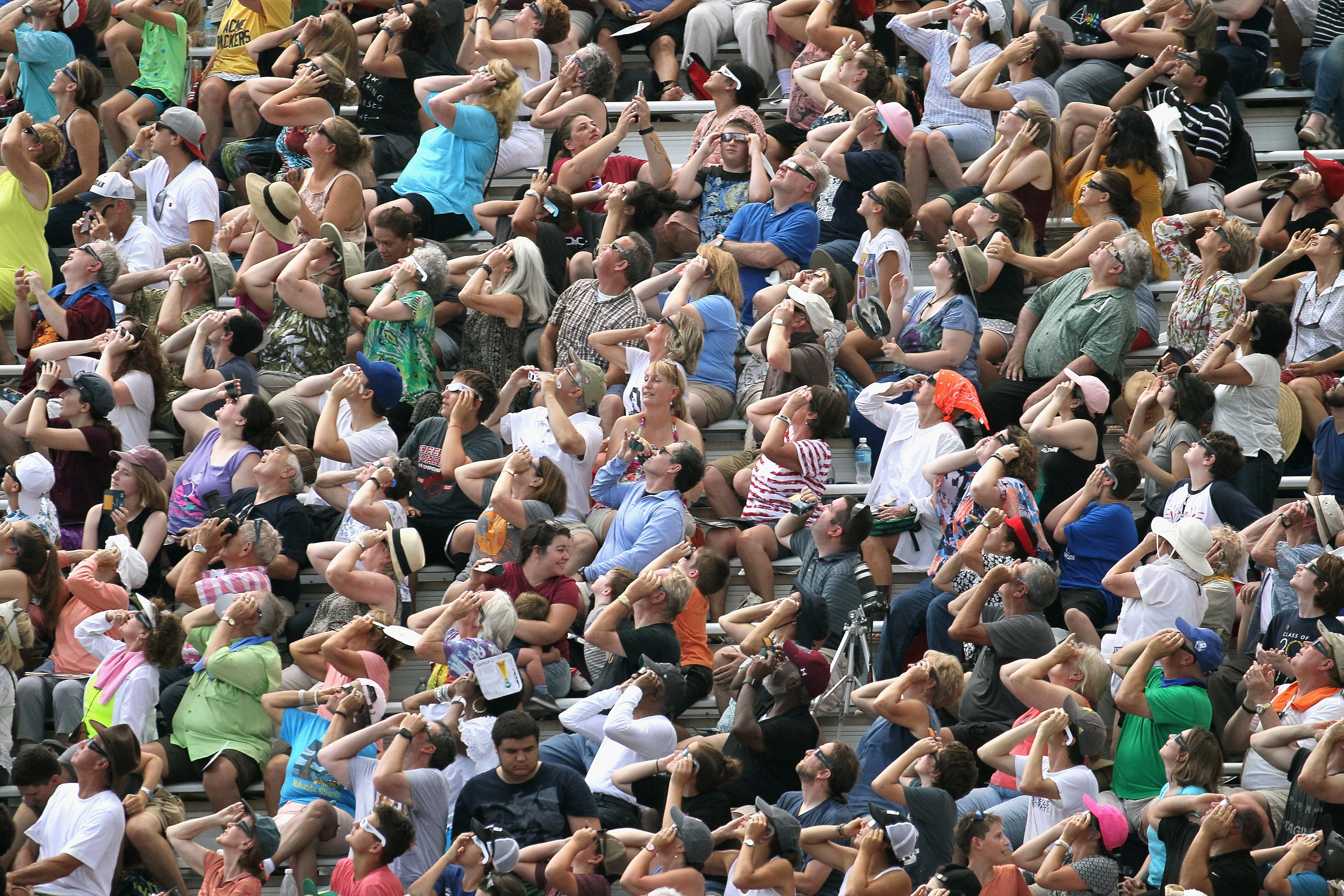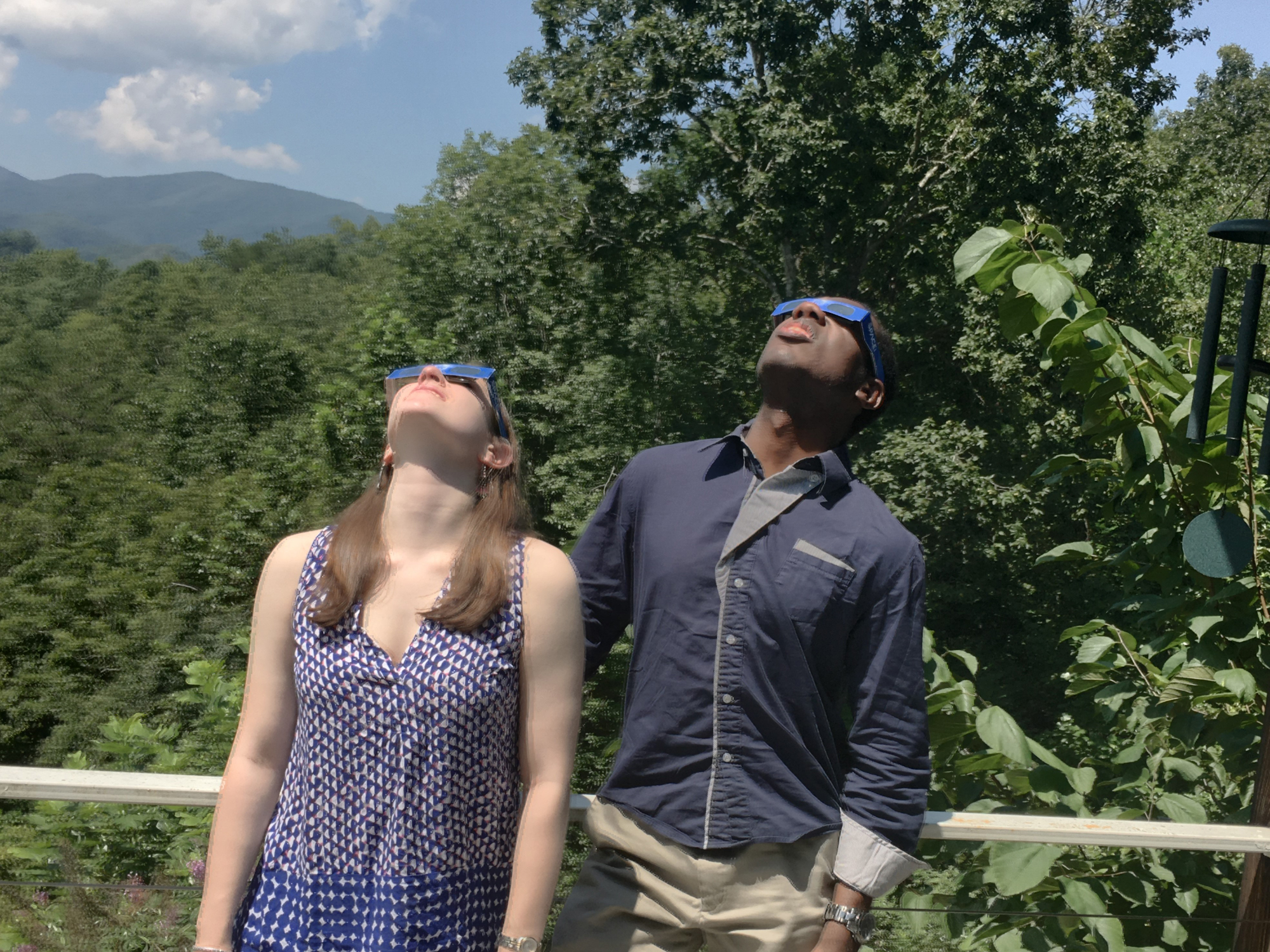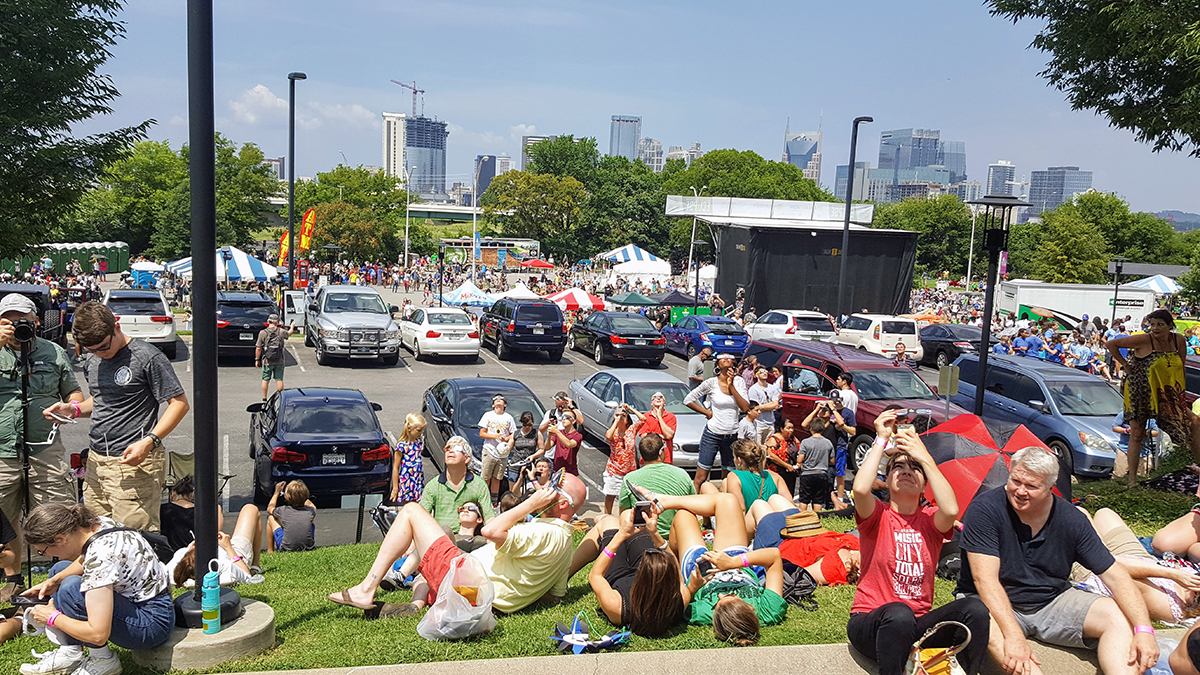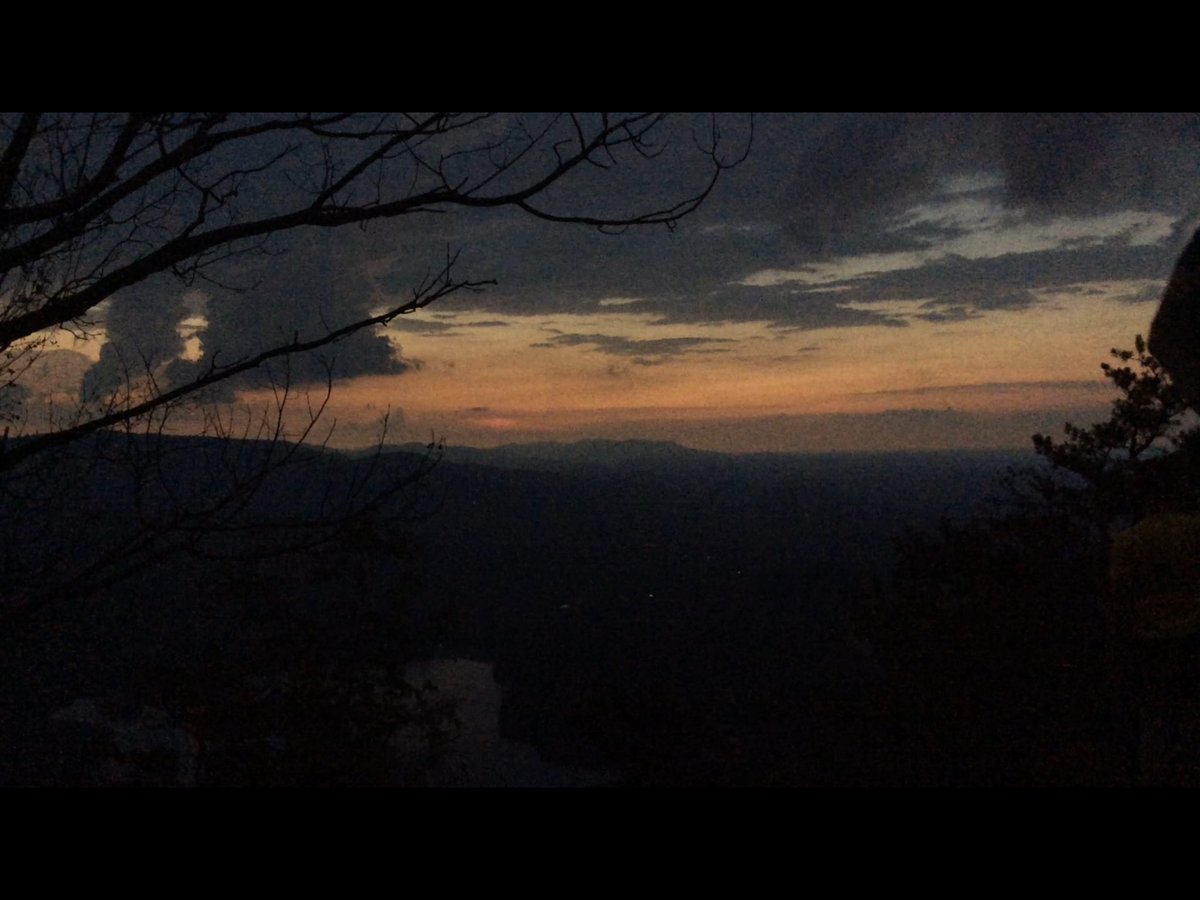Space.com Staffers Experience the Total Solar Eclipse
Five Space.com staff members traveled to locations around the U.S. to witness the total solar eclipse of Aug. 21, 2017. It was the first total solar eclipse that any of us had seen in person, and we all came away awed and inspired. Here's our attempt to convey what it felt like to be present for this amazing event.
Tariq Malik, from Carbondale, Illinois

In 16 years of space reporting, I've never felt anything like this.
It's hot, in the 90s, with a forecast of partly cloudy skies for the thousands of spectators (I am one of them) in Southern Illinois University's Saluki Stadium (A saluki is an Egyptian dog, SIU's mascot.) Totality is at 1:20 p.m. CDT, and all eyes are on the weather. Twenty minutes before totality, a dark cloud parks itself over the sun (No!) with the moon ever creeping across the star's face. The crowd starts stomping. Now they're chanting: "Move that cloud! Move that cloud!"
A short break in the cloud, and the now the sun is almost totally eclipsed. I check with my eclipse safety glasses. But the cloud closes again.
I had a whole plan for this eclipse. I'm going to look for planets — Mercury, Venus and Jupiter —and shadow bands. I want to see the strange shadows. And now all I can think about is this cloud, and I've forgotten the planets and weird animal behavior and the rest. I'm on the phone with MSNBC (they want my immediate reaction later), and now we're all screaming because there's another tiny break in the cloud — and there it is! The totally eclipsed sun, for just a second.
I scream at Denise Chow (of Live Science). She's standing on the field 20 feet away. "Denise! It got dark!" I scream incredulously, though I knew full well what was going to happen. Had been preparing years for this. And yet….
Get the Space.com Newsletter
Breaking space news, the latest updates on rocket launches, skywatching events and more!
I feel small. I feel like the universe. And connected to everything in between.
And then the sun peaks back out though the cloud and MSNBC is asking me what it was like, so I wipe the tears from my face and try to explain. I don't do it justice.
I understand what all those eclipse chasers were trying to say now. With just 1 second, not even the full 2 minutes and 38 seconds we had hoped for, it was enough. And I'm going to see it again.
April 8, 2024, I'm looking at YOU. [Rare Coast-to-Coast Total Solar Eclipse Thrills Millions Across U.S.]
Calla Cofield, from Rexburg, Idaho
The day started out bright. Very bright. Like midsummer, blue sky, laundry-detergent-commercial brightness. As we walked two blocks to a public park, we passed people sitting in chairs on their lawns (or roofs), wearing eclipse glasses and looking up at the sky. Everyone is outside. Everyone is waiting.
When we reached the park, we picked a spot on the grass among a few hundred people, put on our own glasses and laid back to watch the moon’s progress.
When I slipped the glasses off for a moment to look around, the world had become noticeably dimmer. Not exactly in the way it gets dim in the evening, because the sky was still bright blue and the sun was still overhead; This was something unique, something that didn't make sense. The light that wrapped around us was slightly green; my eyes couldn’t quite adjust to it. Strange is very best word to describe it, and it was a little disturbing to watch that dimness grow.
Then, in the last 30 seconds before totality, things got really dark. When the moon fully covered the sun, I couldn’t believe the blackness that descended. This wasn't twilight, this was more like an hour after sunset. The 360-degree sunset was more vivid that I'd imagined it would be; the entire horizon was on fire. The bright red color faded into orange and then into the deep blackish- blue that surrounded the sun and the moon.
The uneasiness I'd felt was gone; I was filled with joy. Some people were shouting — the way you shout when you're startled or when you're at a sporting event — but the only noise that slipped out of me was the word "wow," repeated over and over again. The event wasn't shocking or invigorating, it was calming and inspiring.
If I become an eclipse chaser after this, it's not so much because I want to repeat the experience but because I want to have time to think about it more deeply. I could barely absorb everything that was going on before it was over.
When the sun crept back out from behind the moon, the world seemed so much brighter than it had right before totality; our eyes had adjusted to the darkness, and this strange green light seemed brilliant by comparison. [Solar Eclipse 2017 in Idaho: Totality From Rexburg]
Sarah Lewin, from Greenville, North Carolina

I spent most of my early eclipse time trying to take pictures of it. We were on an isolated balcony in the North Carolina mountains, and the sun beating down on us made it incredibly warm as I held solar binoculars in place so my fiancé could slide a phone under them for a disappointing shot.
The weather forecast had warned of a thunderstorm happening shortly after 2 p.m. — totality would hit at 2:35 — but there was no sign so far, save a cloud or two casually floating by. I'd spent the previous night peering up at an incredible number of stars in the sky, and seeing the Milky Way for the first time, and even a shooting star. (It might have been a Perseid; it angled from that direction.) Before this, my skywatching highlight was spotting the Big Dipper in Central Park one time, and seeing the total lunar eclipse in 2015.
The sun stayed bright in the sky through most of the partial eclipse, as I looked for a change in the quality of light, as I worked with projections and photos through filters, but the shine was steady as the sun sliver slimmed. Until —
Wait, OK, it's getting really dark now!" I said, a bit panicky… but it was just an isolated cloud passing over.
Then, after a time, behind the cloud, there was a bright, shining ring. And the cloud dissipated — it didn't drift away that I remember, it kind of dissolved — and there it was. Totality, sharp and white against the darkened sky, with sunrise all along the mountains surrounding us, a few stars and Venus making rare daytime encores. And for those 2 minutes and change, I didn't even try to take a picture. (Luckily, my mother did.)
After, all there was to do was sit back and feel the sun return and the balcony warm, image already fading in my head of just what exactly that crisp ring had that the photographs never capture. And then to drive back, 3 hours turning into 8 on the overcrowded streets.
Hanneke Weitering, from Nashville, Tennessee

Nothing could have possibly prepared me for my first total solar eclipse.
Before Aug. 21, I had seen plenty of photos and time-lapse videos of the moon crossing the sun, and reported on dozens of stories about anything and everything eclipse-related. I had seen how eclipse chasers go wild with excitement as they describe how awesome totality is. I knew what to expect – or at least I thought I did. Three days later, I'm still trying to wrap my head around the surreal experience that was my first total solar eclipse.
I chose to watch the Great American Solar Eclipse in Nashville, Tennessee, the largest city in the path of totality and home to many of my friends and family. My first stop was at my parents' house in my hometown of Knoxville, where my husband, Michael, and I picked up my old car. We had heard that traffic on Aug. 21 would be the worst in U.S. history, and knowing that we would be in the most populated city in the path of totality, we made sure to allow plenty of extra travel time. As it turned out, there was hardly any more traffic than usual. We drove down I-40, through downtown and all around the city on Sunday, Monday and Tuesday, with no problems at all.
Early Monday morning, we headed over to the Adventure Science Center for the Music City Solar Eclipse Festival, where thousands of people had gathered in the blistering heat to watch the eclipse together. All day long the sky looked pretty clear, which was a relief. One week earlier, the weather forecast called for a 40 percent chance of rain on eclipse day. But by Monday, that had dropped to 1 percent. It was an eclipse miracle!
Or so we thought.
Around 1 minute before totality — just as people in the crowd started shouting at everyone to look up and wait for the "diamond ring effect" and "Baily's beads" — a colossal ninja cloud came out of nowhere. I tried reassuring people, saying, "All hope is not lost," because I had learned that the cold air beneath the shadow of the moon could break up convective clouds in the sky. And I could definitely see that cloud trying to break. It just didn't quite thin out fast enough to give us a peek at totality. No corona for us. Not today.
It may sound like a huge bummer to have a cloud steal totality, but there is a bright side to this dark cloud. When darkness fell over Nashville, instead of spending my 2 minutes of totality gazing at the most-hated cloud in all of Nashville, I took the opportunity to look around and see how Earth was responding to the moon's shadow. I saw what looked like a sunset in 360 degrees. Skies turned purple and orange. Cicadas, which usually make sounds only at night, started screeching. Birds everywhere returned to their nests simultaneously.
I had been sweating in the summer heat all day, and suddenly my skin was covered in goosebumps. I don't know if the goosebumps resulted from the drop in temperature or the fact that I was freaking out over the eclipse. Or perhaps it was a combination of the two. It felt like Mother Nature had slipped some LSD into my coffee. Even though we didn't see totality directly, it was still the coolest natural phenomenon I have ever witnessed. Missing out on seeing the sun's corona just means that now I definitely have to go chase another total solar eclipse!
Doris Salazar, from Table Rock Park, South Carolina

Go tell it — the solar eclipse tale — on a mountain.
I flew from New York City with my boyfriend, Javier, to Atlanta. From there we drove to Greenville, South Carolina, to spend a night at a motel. On the morning of Aug 21, we drove north through the South Carolina countryside to our eclipse mecca: Table Rock State Park. It was all uphill from there.
Javier and I stopped 12 times up the long, hard trail. We rationed out our water supply, as the hot sun teased us about what it would perform in the afternoon. We saw folks come back down the mountain, and we saw folks settle into a viewing spot early on the trail. But Javier and I insisted on finding the best view, at the farthest edge of the Table Rock mountaintop. We sometimes scaled the mountain with our hands, and walked along steep red clay inclines. When the path was flat, we reminded ourselves the soreness would be worth it.
We saw a dad carry his daughter on his back, groups of friends championing themselves up the mountain with funny jokes, and Beatles' music playing off mobile jukeboxes. We kept each other going. Then, Javier and I came upon the precipice we knew was meant for us, because I saw the lake beyond the cliff's edge, the same lake I had photographed at 7 a.m. An airplane flew through the valley at eye level – we had climbed higher than that airplane. We saw three hawks soar by us, not over us.
And then, there were surprise clouds. Javier and I lay on the rocky ground, not far from water pools with moss, and put on our solar eclipse viewers. We saw nothing. But then, the sun peeked out. I wasn't sure if the clouds were playing games with my eyes.
It turned out to be the partial eclipse, and all 30 of us on that side of the mountain realized it within a few moments of each other. Excitedly, we counted down, lying flat on the rocky cliff with our eclipse glasses on.
The last moments of partiality were dramatic: the sun was filtered through thin cloud coverage, and then we had a break. I kept removing my glasses to view the darkness descending over the mountaintops.
Then, the sun was totally eclipsed. I heard Javier shout along with the crowd. The views were unforgettable – the countryside was filled with a peach-colored sunset from all sides, and crickets began to chirp.
The eclipse made me feel something primal: I reacted to being covered in this strange light. I experienced a nurtured feeling, and the dimming lights asked my body to slow down, to disengage, to soften. To become childlike. Everyone was lost in wonder, and then Venus suddenly appeared like a jewel. The clouds came in again, and although the eclipse was gone from view, everything stayed dim. It wasn't until saw the light return around me that I knew totality had passed. It was sublime. And I felt everyone knew the hike to the top was well worth the pilgrimage.
Follow us @Spacedotcom, Facebook and Google+. Original article on Space.com.
Join our Space Forums to keep talking space on the latest missions, night sky and more! And if you have a news tip, correction or comment, let us know at: community@space.com.

Space.com is the premier source of space exploration, innovation and astronomy news, chronicling (and celebrating) humanity's ongoing expansion across the final frontier. Originally founded in 1999, Space.com is, and always has been, the passion of writers and editors who are space fans and also trained journalists. Our current news team consists of Editor-in-Chief Tariq Malik; Editor Hanneke Weitering, Senior Space Writer Mike Wall; Senior Writer Meghan Bartels; Senior Writer Chelsea Gohd, Senior Writer Tereza Pultarova and Staff Writer Alexander Cox, focusing on e-commerce. Senior Producer Steve Spaleta oversees our space videos, with Diana Whitcroft as our Social Media Editor.









